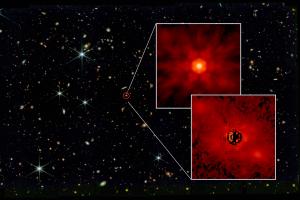Blog
The Distant Large
11 May 2024
 NASA
NASASupermassive black holes are central to the dynamics and evolution of galaxies. They play a role in galactic formation, stellar production, and possibly even the clustering of dark matter. Almost every galaxy has a supermassive black hole, which can make up a small fraction of a galaxy’s mass in nearby galaxies. While we know a great deal about these gravitational monsters, one question that has lingered is just how supermassive black holes gained mass so quickly.
Most of what we know about early black holes comes from quasars. These occur when supermassive black holes are in an extremely active phase, consuming prodigious amounts of matter and emitting intense light that can be seen across the Universe. Observations from the James Webb Space Telescope (JWST) and other observatories have observed quasars as far back as 13 billion years ago, meaning that they were already large and active just a few hundred million years after the big bang. But these brilliant beacons also pose an observational challenge. Early quasars are so bright they vastly outshine their host galaxy, making it difficult to observe the environments of early quasars. But a new study in The Astrophysical Journal has used a spectral trick to see these distant galactic hosts.1
The team gathered JWST data on six distant quasars known to be about 13 billion light-years away. Since the quasars were observed at a range of wavelengths, the team then compared the light to model quasars and was able to categorize which wavelengths likely came from the compact source of the quasar, and which from the more diffuse galaxy surrounding it. By filtering out the quasar light, they obtained the first images of the distant galaxies that are home to these ancient quasars.
Since the brightness of each light source is related to its mass, the team could compare the mass of a quasar to the mass of its host galaxy. The result was surprising. In these early galaxies, the mass of the supermassive black hole is about 10% of that of the galaxy. This is much larger than the mass ratio seen in local galaxies, where supermassive black holes can comprise just a tenth of a percent of a galaxy’s mass. This likely means that early supermassive black holes grew extremely quickly, and could have even been the seeds of their galaxies. The observations go against the idea that early galaxies formed first and that their black holes formed later.
Astronomers still don’t know just how supermassive black holes formed so quickly in the early Universe, but it’s now clear that they did. In answering one question about the evolution of supermassive black holes, the team has raised several other questions.
Yue, Minghao, et al. “EIGER. V. Characterizing the Host Galaxies of Luminous Quasars at z ≳ 6.” The Astrophysical Journal 966.2 (2024): 176. ↩︎